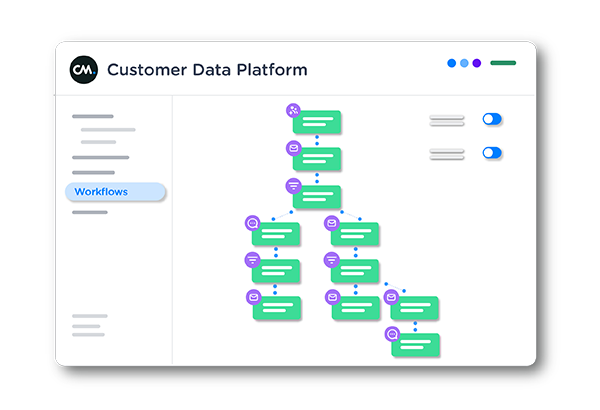What is a Customer Data Platform?
A customer data platform (CDP) is a system that combines data from multiple sources to create a unified, holistic view of each customer. This can include data from various sources such as website interactions, mobile apps, email campaigns, customer service interactions, and more. The goal of a CDP is to provide a single source of truth for customer data that can be used to personalize and optimize the customer experience.
Click here to learn more about the differences between DMPs, CRMs and CDPs.
So what does a CDP do?
CDPs can be used in various ways, including delivering personalized content and offers, improving customer service, optimizing marketing campaigns, and more. In its purest form, a customer data platform collates and sorts data collected from various sources.
First-party data – data gathered directly from your own data collection efforts. For example, that might be data you've gleaned directly from a purchase or a newsletter sign-up.
Second-party data – data that's been sourced from outside of your organization. For instance, that might be an email or customer data list you've purchased.
Third-party data – anonymized data collected from third-party browser cookies (due to be phased out and replaced by the mysterious Google Privacy Sandbox in 2023) or information from platforms such as Google Analytics.
Primarily, it's the first-party data that we're interested in. First-party data is the purest, cleanest and most valuable data you can hold, but on its own, it will only allow you to target existing customers or people that have interacted with your brand. When combined with second and third-party data, you can build look-alike audiences that will increase the reach of your marketing efforts and help you uncover potential new customers who have an affinity with your brand.
Once the data is gathered, the Customer Data Platform assists with the following:
Data collection and integration: CDPs gather data from a wide range of sources and integrate it into a single, unified view of the customer.
Data management: CDPs provide tools for cleaning, de-duplicating, and enriching customer data.
Segmentation: CDPs allow marketers to segment their customers based on a wide range of criteria, such as demographics, behaviours, and purchase history.
Profile management: CDPs provide a way for marketers to create and manage detailed profiles for each customer, including demographics, behaviours, and preferences.
Real-time decisioning: CDPs provide real-time decisioning capabilities that allow marketers to deliver highly personalized customer experiences.
How is the Customer Data Platform useful?
Personalization: The Customer Data Platform can deliver highly personalized experiences across all touchpoints by providing a unified, holistic view of each customer. For example, a CDP can provide personalized content and offers to customers based on their browsing history, purchase history, and other information.
Improved customer service: CDPs can provide customer service representatives with a complete view of each customer's interactions and history, allowing them to provide more personalized and efficient service.
Better targeting and segmentation: CDPs allow marketers to segment their customers based on a wide range of criteria, such as demographics, behaviours, and purchase history. This makes creating more effective marketing campaigns possible by targeting the right customers with the right message.
Increased efficiency: CDPs can help businesses streamline their processes and work more efficiently by providing a single source of truth for customer data. For example, CDPs can help reduce the time and effort required to create customer profiles and segments and automate many other data-related tasks.
Measurement and Optimization: CDPs help to track and measure customer engagement and also help to optimize it. Analyzing customer data can reveal the customer's behaviour patterns and preferences, which can help businesses make smarter decisions and improve their marketing strategies.
Why do businesses need a CDP?
Businesses need a customer data platform (CDP) because it allows them to create a unified, holistic view of each customer, which can be used to improve the customer experience and drive revenue growth. Here are a few specific reasons why CDPs are becoming increasingly crucial for businesses:
Increased customer expectations: Customers expect personalized, relevant experiences from the brands they interact with. A CDP can help businesses deliver these experiences by providing a unified view of each customer that can be used to personalize interactions and optimize the customer experience.
Data fragmentation: As businesses increasingly use a variety of digital channels to interact with customers, customer data becomes fragmented and siloed. A CDP can help bring all this data together, creating a single source of truth for customer data.
Complex customer journeys: Customers interact with businesses across many touchpoints and channels, making it difficult to understand the customer journey. A CDP can help companies gain a holistic view of the customer journey, which can optimize the experience and drive revenue growth.
Multichannel measurement and optimization: A CDP allows businesses to track customer engagement across multiple touchpoints and channels and measure it. This can help businesses to optimize their marketing strategies to increase customer retention and revenue.
Compliance and Governance: CDPs also include data governance features that help businesses manage and protect customer data, which is critical for compliance with data protection regulations such as GDPR and CCPA.

How to choose the right Customer Data Platform for your business?
Choosing the right customer data platform (CDP) can be a complex process, as many different options are available, each with its strengths and weaknesses. Here are a few key factors to consider when evaluating CDPs:
Data integration: Ensure the CDP can integrate data from various sources and channels, including website interactions, mobile apps, email campaigns, social media, and more.
Data management: Look for a CDP with robust data management capabilities, such as data cleaning, de-duplication, and data enrichment, and can handle large volumes of data.
Real-time decisioning: Ensure the CDP enables real-time decisions and delivers personalized experiences.
Segmentation: Look for a CDP that allows you to segment your customers and manage their profiles based on a wide range of criteria, such as demographics, behaviours, and purchase history.
Scalability: Make sure the CDP can scale to meet your needs as your business grows and the volume of data increases.
Data privacy and governance: Evaluate the CDP's capability to comply with data protection regulations such as GDPR and CCPA and its data governance features.
What is the future of the Customer Data Platform?
Here are a few ways CDPs are expected to evolve in the future:
Greater intelligence: CDPs will likely become increasingly intelligent, using advanced analytics, machine learning, and artificial intelligence to gain deeper insights into customer behaviour and preferences.
Greater automation: CDPs will automate many of the processes related to customer data management, including data collection, data integration, data cleaning, and data enrichment, allowing businesses to focus on delivering personalized experiences and optimizing the customer journey.
More real-time: CDPs will be increasingly able to process and act on customer data in real-time, allowing businesses to deliver highly personalized experiences at the moment.
More Integrated: CDPs will become increasingly integrated with other systems such as CRM, Marketing Automation Platforms (MAPs), and analytic platforms (AP) to provide a complete view of the customer journey.
More privacy focus: As regulations and customers' expectations around data privacy and security evolve, CDPs will likely need to become more sophisticated regarding data governance and protection capabilities to comply with regulations and protect customers' trust.
More data sources: CDPs will continue to collect data from a wider range of sources, such as IoT devices, VR/AR, and other emerging technologies.
Final Thoughts
The future of customer data platforms (CDPs) looks promising as more and more businesses recognize the value of a unified, holistic view of their customers in delivering personalized experiences and driving revenue growth. Overall, CDPs are expected to play a crucial role in the future of customer engagement, providing businesses with the tools they need to deliver highly personalized experiences and drive revenue growth.








